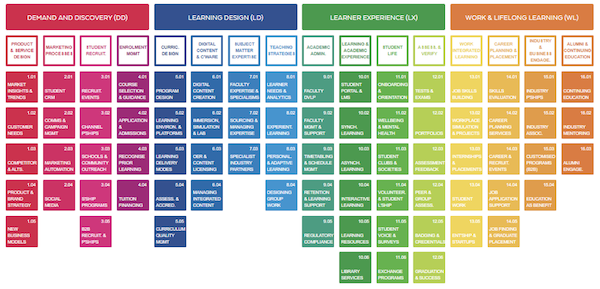Published on
Digital Capability Framework and Sustainable Online Models of Higher Education

Higher education leaders know that online teaching and learning is far more complex than the emergency remote learning that many have experienced during COVID-19. The pandemic has actually brought to the fore the many variables online leaders have long known are necessary for a quality and cohesive online learning ecosystem. Because of the pandemic, colleges and universities have been pushed to introduce some new elements necessary to delivering virtual learning and supporting online experiences, whether or not they had strategically prepared for such a change. To deliver an online student experience, many institutions wrestle in real time with how to deliver an online student experience across the student journey. This may range from needing to deliver courses fully online, creating virtual tours and enticing students to enroll at the institution, enabling online support services such as library resources, online tutoring and increasingly important mental health services to name but a few.
Riding this momentum, savvy distance education leaders are leveraging their new insights and experiences in the pivot to online learning. This offers the opportunity to explore new ways of delivering and supporting students during a time of uncertainty across the student lifecycle. Such efforts involve thinking differently about traditional higher education models and challenging institutions to consider how to put students at the center of the user experience. In doing so, new operating models and technology systems may emerge to underpin future strategic directions and strengthen institutional value propositions.
In the face of many pressures, digital capabilities are paramount to meeting online learning demands. This is particularly true for creating robust online experiences that meet the demands and expectations of today’s digital native students. To identify potential areas of opportunity for digital innovation, leaders can start by looking across the learner lifecycle to identify places to better leverage technology to attract students, deliver a personalized online course experience, and prepare graduates for success in their desired industries. This system seeks to combine a spectrum of digital solutions with an integrated approach. Utilizing a framework to examine and plan digital capabilities helps inform such digital transformations.
Holon IQ and the Higher Education Digital Capability Framework open-sourced in 2020 share one such example of a digital transformation framework. This framework provides a snapshot of the many aspects of the student experience tied to potential areas for digital innovation. This framework presents a refreshing “whole learner” approach organized across the many support intersections typically found in higher education. Four learner dimensions are mapped out across the learner lifecycle: 1) demand and discovery, 2) learning design, 3) learner experience, and 4) work and lifelong learning (Holon IQ. 2020). The four domains are further broken into 16 subdomains and 70+ digital capabilities that innovative leaders may consider as they develop their digital ecosystems. Using such a framework, leaders are able to evaluate current capabilities and evaluate new ones and align them with their institutional strategic objectives and priorities.

Regardless of where an institution is in building its digital capabilities, it is important to remind leaders that such digital transformation is a journey not a destination. For many, COVID-19 has accelerated this journey while shedding new light on the institutional needs necessary to meet the needs of the modern student. Framed through a journey mindset, the 16 domains within the digital capabilities framework reflect a lifecycle of institutional capabilities related to higher education functions. These capabilities may include areas such as admissions and recruitment, curriculum design and development, teaching and learning, career planning, alumni engagement, and continuing education. These domains provide a valuable perspective on the relationship between functional area units and departments and identify opportunities for shared systems and technologies. Through this understanding, new educational models can be designed in a coordinated effort to transform an institution’s business model and evolve its digital ecosystem.
The Holon IQ Digital Capabilities tool informs opportunities needed to evolve online learning. By using this framework, leaders can zoom out to look at the entire digital capability infrastructure and quickly find relevant blocks related to their current institutional structure and function. By zooming in, the framework can identify areas of strategic importance applicable to the functional areas that they might wish to delve into more deeply. Overall, the use of such a framework is useful in teasing out potential opportunities that advance the digital experience.
Let us not waste a good crisis. COVID-19 has unexpectedly catapulted institutions worldwide into conversations about digital capabilities. While the start of this journey may have involved rapid shifts to digital technologies such as using video conferencing, it has also exposed the great lack of digital capabilities necessary to support an online ecosystem. As institutions learn from the past several months, bold thinking is required to advance opportunities for true digital transformation. To shape strategic approaches for implementing such capabilities, leaders must begin their journey by leveraging such tools as Holon IQ’s digital capabilities framework. While enhancing individual digital capabilities does not necessarily transform an online digital ecosystem, collectively it does allow institutions to make thoughtful steps on their digital journey. Using digital capabilities as part of a coordinated institution-wide model shifts foundational efforts such as digitizing information from paper documents and streamlining processes to a series of integrated, and coordinated technology shifts across the student lifecycle. Such a transformation involves thoughtful leadership, collaboration, and a focus on strategies and processes that shape new directions underpinned by digital capabilities. Ultimately, these efforts will help position institutions to better serve their students today and tomorrow.
References
Holon IQ (2020). Higher education digital capability framework. Retrieved from https://www.digitalcapability.org/#us-section
Reinitz, B. (2020). Consider the three ds when talking about digital transformation. Retrieved from https://er.educause.edu/blogs/2020/6/consider-the-three-ds-when-talking-about-digital-transformation
Disclaimer: Embedded links in articles don’t represent author endorsement, but aim to provide readers with additional context and service.
Author Perspective: Administrator



